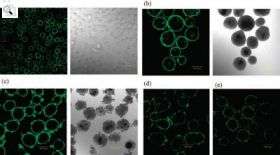Boosting survival of insulin-cell transplants for Type 1 Diabetes

Researchers in Japan are reporting a discovery that could improve the effectiveness and expand the use of transplants of insulin-producing cells to treat diabetes. Their study is scheduled for the July 16 issue of ACS' Bioconjugate Chemistry. Insulin-dependent, or Type 1, diabetes affects about 800,000 people in the United States.
In the new study, Yuji Teramura and Hiroo Iwata point out that transplantation of the pancreas's insulin producing cells, so-called islets of Langerhans, is a promising experimental technique for treating patients with insulin-dependent diabetes.
However, the procedure is not sufficiently effective for many people. This is because the body destroys many of the islet cells right after transplantation in an inflammatory reaction triggered by blood clotting on the surface of the cells, the researchers say.
To address this problem, the scientists coated islet cells with a special polymer film containing heparin, an anticoagulant, or urokinase, a medication that dissolves blood clots. In laboratory studies, the researchers showed that the coatings delayed the clotting long enough to prevent the destruction that otherwise would occur immediately after transplantation.
The coatings did not affect the ability of the cells to produce insulin, the researchers add.
Source: ACS
















